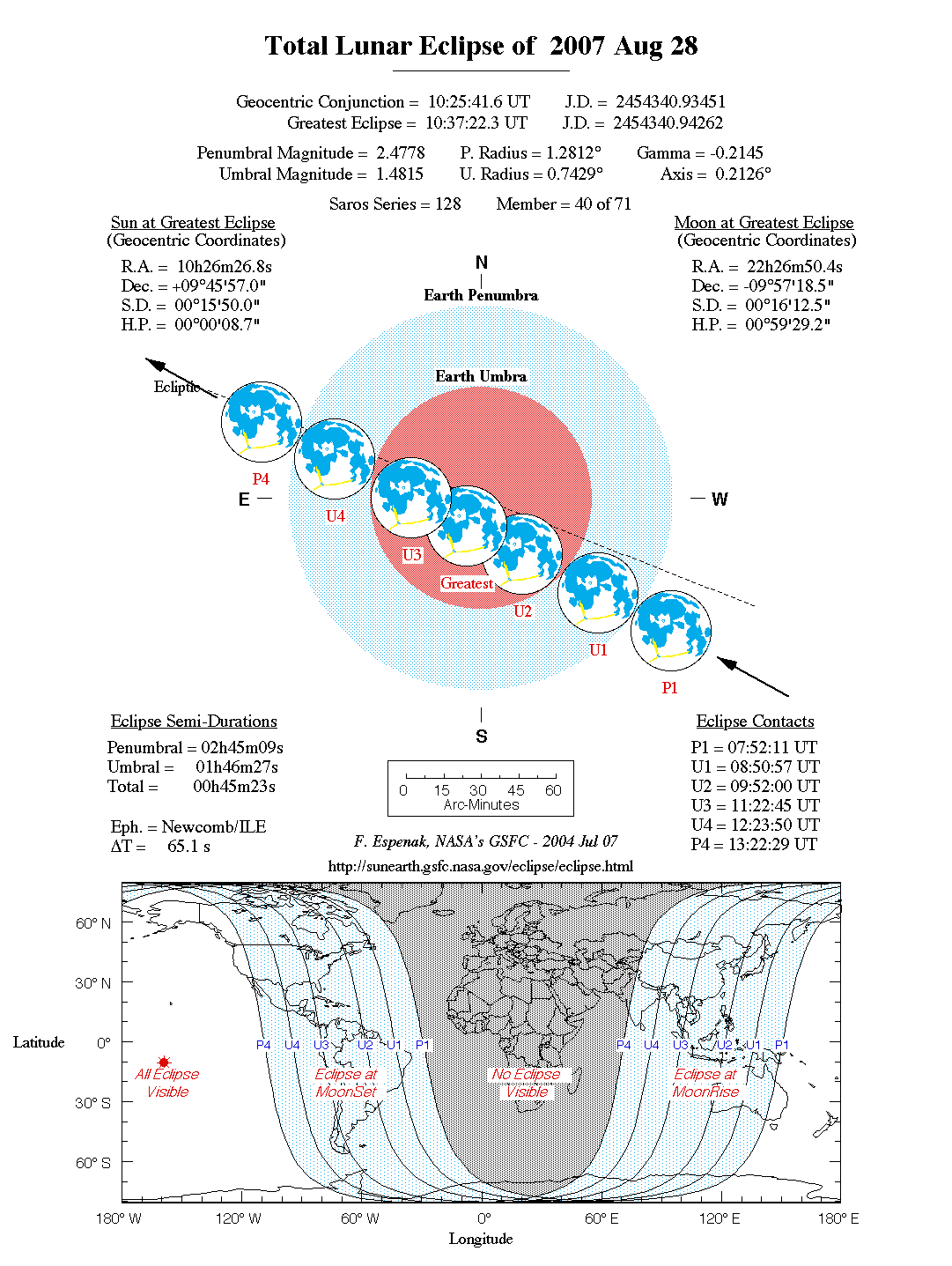이번 개기월식은 동쪽에서 남쪽방향으로 약 15도 쯤에서 달이 떠오릅니다.
개기월식이 진행된 상태라 붉은색이며, 왼쪽이 지구 그림자를 빠져 나오면서 21:30 경 식이 종료됩니다.
이때 남동쪽에서 고도 30도 정도이므로 사진 찍으실 분들은 화각 잘 계산하셔서 찍으시기 바랍니다.
아래는 NASA 에서 제공하는 개기월식 자료입니다.
Total Lunar Eclipse of August 28
The second lunar eclipse of the year is another total eclipse. It is a deeper event since it is the first central total eclipse since 2000. The eclipse occurs at the ascending node of Luna's orbit in southern Aquarius. Since the Moon is 2.6 days shy of perigee, it will appear 8% larger (= 1.2 arc-minutes) than it was during March's eclipse. The Moon's trajectory takes it deep into the southern umbral shadow, resulting in a total eclipse that lasts 90 minutes. At mid-totality the Moon's centre passes just 12.8 arc-minutes south of the shadow axis. This places the Moon's northern limb only 3.4 arc-minutes north of the axis while the southern limb is 15.4 arc-minutes from the umbra's southern edge.
Since different parts of the Moon will probe radically different portions of Earth's umbral shadow, a large variation in shadow brightness can be expected. As a consequence of this geometry, the southern half of the totally eclipsed Moon will appear considerably brighter than the northern half. Observers are encouraged to estimate the Danjon value at mid-totality (see Danjon Scale of Lunar Eclipse Brightness).
The penumbral phase of August's eclipse begins at about 07:54 UT, but most observers will not be able to visually detect the shadow until about 08:30 UT. A timetable for the major phases of the eclipse is listed below.
Penumbral Eclipse Begins: 07:53:39 UT
Partial Eclipse Begins: 08:51:16 UT
Total Eclipse Begins: 09:52:22 UT
Greatest Eclipse: 10:37:22 UT
Total Eclipse Ends: 11:22:24 UT
Partial Eclipse Ends: 12:23:30 UT
Penumbral Eclipse Ends: 13:21:01 UT
The Moon's path through Earth's shadows as well as a map illustrating worldwide visibility of the event are shown in Figure 3.
At the instant of mid-totality (10:37 UT) the Moon will stand near the zenith for observers in French Polynesia. At that time, the umbral eclipse magnitude will be 1.4760.
All of North America will witness some portion of the eclipse, but western observers are favored. The early penumbral or umbral phases will be in progress at moonset for observers in Maritime Canada. From the eastern USA, the Great Lakes region and Ontario, the Moon sets in total eclipse. Only observers to the west of the Rockies (including Alaska) will be treated to the entire event. All phases of the eclipse are also visible from islands of the Pacific Ocean, New Zealand and eastern Australia. Various stages of the eclipse are in progress at moonrise for eastern Asia. No eclipse is visible from Europe, Africa and western Asia.
Table 3 lists predicted umbral immersion and emersion times for 20 well-defined lunar craters. The timing of craters is useful in determining the atmospheric enlargement of Earth's shadow (see Crater Timings During Lunar Eclipses).

Figure 3
Total Lunar Eclipse of 2007 August 28
Table 3
Crater Immersion and Emersion Times for the
Total Lunar Eclipse of 2007 August 28
UT of UT of
Immersion Crater Name Emersion Crater Name
08:58 Grimaldi 11:26 Grimaldi
08:59 Aristarchus 11:31 Billy
09:04 Kepler 11:36 Aristarchus
09:05 Billy 11:38 Kepler
09:10 Pytheas 11:39 Campanus
09:11 Copernicus 11:45 Tycho
09:12 Timocharis 11:47 Copernicus
09:13 Plato 11:47 Pytheas
09:18 Campanus 11:51 Timocharis
09:22 Aristoteles 11:53 Plato
09:22 Eudoxus 12:01 Aristoteles
09:24 Manilius 12:01 Manilius
09:27 Menelaus 12:02 Eudoxus
09:30 Tycho 12:05 Menelaus
09:30 Dionysius 12:05 Dionysius
09:31 Plinius 12:08 Plinius
09:39 Proclus 12:15 Goclenius
09:41 Taruntius 12:17 Proclus
09:44 Goclenius 12:17 Taruntius
09:48 Langrenus 12:20 Langrenus
All times are Universal Time
'별보기 > 하늘 소식' 카테고리의 다른 글
| 07년 제19회 한국 아마추어 천문인의 밤 '별잔치 (STAR PARTY) (0) | 2007.11.02 |
|---|---|
| Comet Holmes 안시관측 가능 (0) | 2007.10.26 |
| 페르세우스자리 유성우 (0) | 2007.08.09 |
| 2007년 7월의 천문현상 (0) | 2007.07.12 |
| 'Clear Signs of Water' on Distant Planet (0) | 2007.07.12 |


